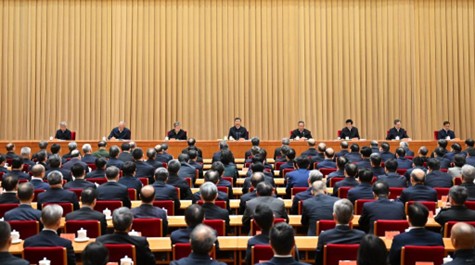BUILDING A COMMUNITY OF SHARED FUTURE WITH NEIGHBORING COUNTRIES: A NEW PARADIGM OF CHINESE DIPLOMACY

At the recent central conference on work with neighboring countries held in Beijing, President of the People’s Republic of China Xi Jinping—who also serves as General Secretary of the CPC Central Committee and Chairman of the Central Military Commission—delivered a keynote address calling for the establishment of a community of shared future with neighboring states. China borders 14 countries, making it one of the nations with the largest number of land neighbors in the world.
What key emphases and political messages emerged from Xi Jinping’s speech? A clear signal was sent indicating a transition in China’s foreign policy toward its neighbors to a new, more systematic level. The necessity of adopting a global perspective on neighboring regions was stressed, and a clear vision was articulated: prioritizing engagement with neighboring countries in the context of national security, sustainable development, and high-level diplomacy.
China intends to deepen strategic mutual trust, jointly support neighboring countries in choosing their own development paths, and promote the resolution of disputes through dialogue. This foreign policy model stands in contrast to confrontational approaches and offers a stable, pragmatic path of engagement in which partnership and mutual support are the dominant principles.
This initiative holds special significance for Kazakhstan, both in terms of strategic positioning and in the context of new horizons for development.
Deepening Political Dialogue and Strategic Trust. Kazakhstan, which shares the longest land border with China, holds a special place in the framework of China’s policy of “amity, sincerity, mutual benefit, and inclusiveness.” The growing role of leaders’ diplomacy means that high-level personal contacts—such as the regular meetings between President Kassym-Jomart Tokayev of Kazakhstan and President Xi Jinping—will become even more significant for developing coordinated strategies and aligning efforts within international initiatives.
A New Wave of Integrative Development. Xi Jinping emphasized the need to build a high-level connectivity network. For Kazakhstan, this entails expanding its transport and logistics potential within the framework of the Belt and Road Initiative, developing joint industrial zones, advancing digital infrastructure, and strengthening production and supply chains. In this context, the Digital Silk Road project and Kazakhstan’s involvement in the creation of transregional corridors—such as the Trans-Caspian route—are gaining particular relevance.
Security as a Shared Responsibility. The Asian model of security is emphasized—one based on dialogue, rejection of bloc thinking, and respect for diversity. Regional trust, multilateral consultations, and the development of security mechanisms are placed at the forefront.
Support for an Independent Path of Development. China emphasizes its refusal to impose any development model, which aligns with Kazakhstan’s multi-vector foreign policy. This enables the country to build sustainable bilateral relations without conflicting with other directions of its international strategy.
Expanding Humanitarian Exchanges and Mobility. Simplifying the movement of people and expanding cultural, academic, and youth programs opens new opportunities for Kazakhstan: strengthening educational ties, increasing tourist flows, and nurturing a new generation of China experts.
This goes beyond bilateral relations with China—it is about forming an integrated space of interconnected development. Neighboring countries are viewed by Beijing as a strategic direction for building regional stability and prosperity. Countries in the region are becoming not just neighbors, but key participants in the realization of China’s global vision—from ensuring energy security to driving digital transformation and sustainable development.
Building a community of shared future with neighboring countries is not just rhetoric—it is a real political direction, through which Central Asia can strengthen its sovereignty, enhance its international standing, and integrate into new economic and technological value chains on an equal footing.
The concept proposed by President Xi Jinping of China represents both a challenge and a unique opportunity. For Kazakhstan and the Central Asian states, it opens up the prospect of strengthening strategic partnership with China against the backdrop of intensifying geopolitical turbulence. However, success in this direction will largely depend on the ability of the region’s countries to clearly and consistently defend their national interests, undertake large-scale infrastructure modernization, accelerate integration processes, and act from coordinated positions on key areas of cooperation with Beijing.
The initiative of President Xi Jinping resonates organically with the position of the President of the Republic of Kazakhstan, Kassym-Jomart Tokayev, who has repeatedly emphasized the priority of deepening the comprehensive strategic partnership with the People’s Republic of China. As the Leader of Kazakhstan notes, the Kazakh-Chinese “eternal comprehensive strategic partnership” is developing dynamically and is oriented toward the long term. President Tokayev expresses confidence that the upcoming visit of the President of China to Astana to participate in the second “Central Asia – China” summit, scheduled for June this year, will become an important milestone in expanding the horizons of bilateral strategic cooperation.
Beijing is demonstrating strategic determination to form a zone of good neighborliness, stability, and shared prosperity, underpinned by the concept of a community of shared future. This model represents an alternative paradigm of international relations, built on the principles of mutual trust, respect for sovereignty, and common development. For countries participating in the Belt and Road Initiative, it opens access not only to large-scale infrastructure and institutional resources but also to a stable security architecture amid increasing global instability.
In this context, the theses voiced at the conference should not be seen as the culmination of current foreign policy, but rather as a strategic call to jointly build a new international order. At its core lie fundamental principles such as sustainability, mutual trust, inclusiveness, and mutually beneficial development—principles capable of bringing a qualitatively new dimension to intergovernmental relations with neighboring countries.
China Studies Center
